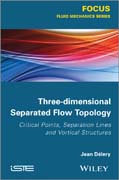
This book develops concepts and a methodology for a rational description of the organization of three–dimensional flows considering, in particular, the case where the flow is the place of separations. The descriptive analysis based on the critical point theory of Poincaré develops conventional but rather unfamiliar considerations from aerodynamicists, who face the understanding of complex flows including multiple separation lines and vortices. These problems concern industrial sectors where aerodynamics plays a key role, such as aerospace, ground vehicles, buildings, etc. Contents 1. Skin Friction Lines Pattern and Critical Points. 2. Separation Streamsurfaces and Vortex Structures. 3. Separated Flow on a Body. 4. Vortex Wake of Wings and Slender Bodies. 5. Separation Induced by an Obstacle or a Blunt Body. 6. Reconsideration of the Two–Dimensional Separation. 7. Concluding Remarks. About the Authors Jean Délery is a Supaero (French National Higher School of Aeronautics and Space) engineer who has worked at Onera (French national aerospace research center) since 1964. He has participated in several major French and European aerospace programs, is the author of many scientific publications, and has occupied various teaching positions particularly at Supaero, the University of Versailles–Saint–Quentin, Ecole polytechnique in France and “La Sapienza” University in Rome, Italy. He is currently emeritus adviser at Onera. INDICE: Introduction to the physics of complex three–dimensional flows and brief history. Structure of the book. Chapter 1 Detachment in three–dimensional flows and vortices. Reminder of the properties of the three–dimensional boundary layer. Spectrum of the wall friction line. Separation lines and separation surfaces. Formation of vortex structures. Horseshoe vortex and tornado vortex. Chapter 2 Separated flow on a body. Appearance of collar singular points and associated separation lines. Rigorous definition of the concept of separated (or detached) flow. Singular points on an isolated body and Poincaré formula. Field associated with a detached configuration. Chapter 3 Wake vortex of slender bodies and wings. Case of the delta–wing Formation of apex vortices and vortex lift. Case of the classical wing. Extremity vortices. Slender body, such as impact missile. Chapter 4 Detachment in front of an obstacle or on a rounded (blunt) body. Formation of the vortices upstream of an obstacle facing upwind (like a building for example). Detachment caused by a body of finite height (or protuberance). Associated back tornado vortices. Detachment downstream of a propelled back–body. Analysis of the vortex system created by a car. Chapter 5 Two–dimensional detachment. Two–dimensional approximation discussed in the framework of the singular point theory. Specific situations and corresponding topological structures. Disturbances and edge effect affecting flows in two–dimensional devices. Reconsideration of the concept of two–dimensional flow. Conclusion
- ISBN: 978-1-84821-450-7
- Editorial: ISTE Ltd.
- Encuadernacion: Cartoné
- Páginas: 176
- Fecha Publicación: 15/02/2013
- Nº Volúmenes: 1
- Idioma: Inglés
